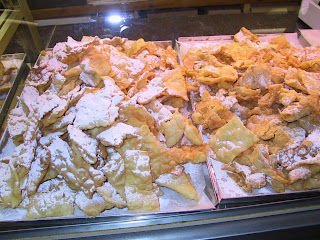
They've never quite gotten over architect Richard Meier's design for the Ara Pacis (the 13AD altar commemorating the triumphs of the Emperor Augustus), a contemporary intruder boldly positioned in the middle of Old Rome.

And after more than 15 years, many Romans haven't yet warmed up to the transformation of the "newly" cleaned and brilliantly revealed Michelangelo's Last Judgment in the Sistine Chapel.
There was something comforting and familiar about those old murky colors with everyone writhing in hell.
So it follows that Romans are fiercely attached to their classic recipes and don't want you fooling around with things.
 Pasta alla Norma is not of Roman origin. But Romans have lovingly adopted it from its Sicilian roots, maybe because this dish makes such nice use of their full-flavored basil and their beloved multicolored eggplants.
Pasta alla Norma is not of Roman origin. But Romans have lovingly adopted it from its Sicilian roots, maybe because this dish makes such nice use of their full-flavored basil and their beloved multicolored eggplants. Like Roman cuisine in general, pasta alla Norma is bold and lively, much like the indomitable plucky heroine of Bellini's opera Norma for which, some say, it was created. (Other theories are floating around on this subject. If you have one, let's talk about it)
Please keep in mind the first rule of Italian cooking: Use only the freshest and highest quality ingredients. If the eggplant is spongy and brownish inside, if the basil is limp and lacks flavor, if your bottle of olive oil costs $1.98, go buy a steak and throw it on the grill instead.
But if you follow this primary rule along with Daniela Del Balzo's recipe (it's a simple dish, but you still have to have a plan), the result will be spettacoloso. You can read about Daniela and her cooking school in Rome at AstheItaliansCook.
PASTA ALLA NORMA


2 eggplants, cut into 1/2 inch cubes (about 2 cups cubed)
2 - 3 tablespoons Canola oil, or Canola oil spray, for frying eggplant
2 tablespoons (30 ml) extra virgin olive oil
2 cloves garlic, peeled and crushed with back of knife
2 cups fresh plum tomatoes, peeled, and roughly chopped or small can (14.5 oz)San Marzano tomatoes, drained and chopped
1- 3 tablespoons tomato puree (called passata in Italy)
2 - 4 tablespoons ricotta salata, grated
1/4 cup fresh basil leaves, chopped
Salt and pepper
1 #rigatoni
Place large pot of water on stove to boil.
Place the eggplant slices on a plate or other flat smooth surface, sprinkle with coarse salt and let set for 30 minutes to remove the bitterness. Wash slices under cold water, dry well with paper towels.
In large non-stick frying pan, heat oil and fry eggplant on both sides until golden brown. (Turn heat to medium low after oil has heated to prevent burning.) Remove slices and let rest on paper towels.
To frying pan, add 2 tablespoons olive oil and the crushed garlic for about 2 minutes (do not let burn). Then add chopped tomatoes, tomato puree, and pinch of salt and pepper. Saute for 15 - 20 minutes or until the sauce reduces slightly. Add eggplant and chopped basil. Cook and stir over medium heat until eggplant softens.
To boiling pot of water, add liberal amount of salt and rigatoni.
Cook rigatoni until al dente and drain.
Add rigatoni to sauce and mix well.
Place in individual serving bowls and top with grated ricotta salata and additional whole basil leaves if desired.
Serves 6.
Buon Appetito!


